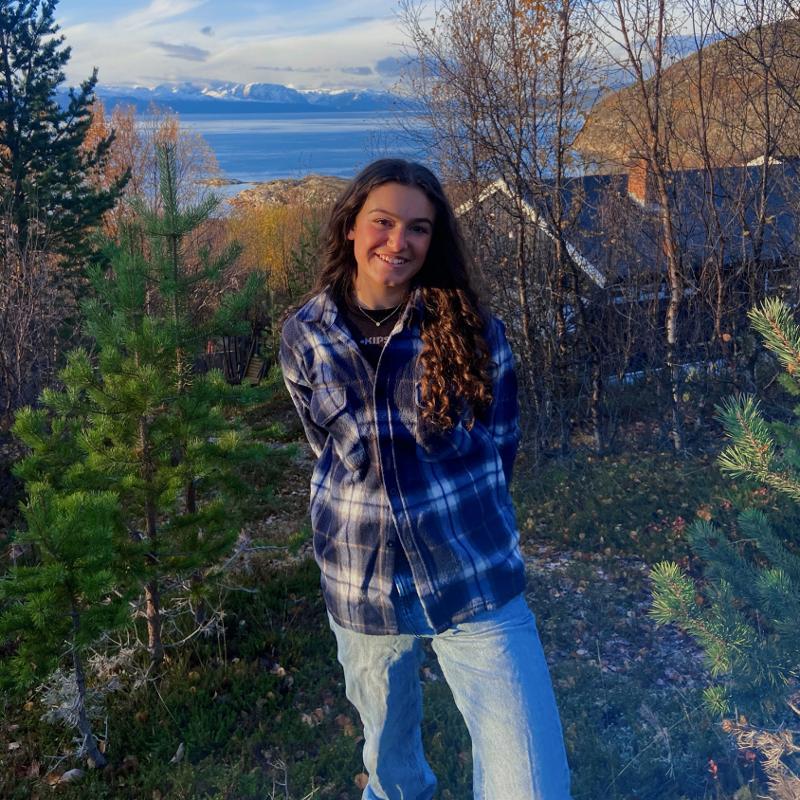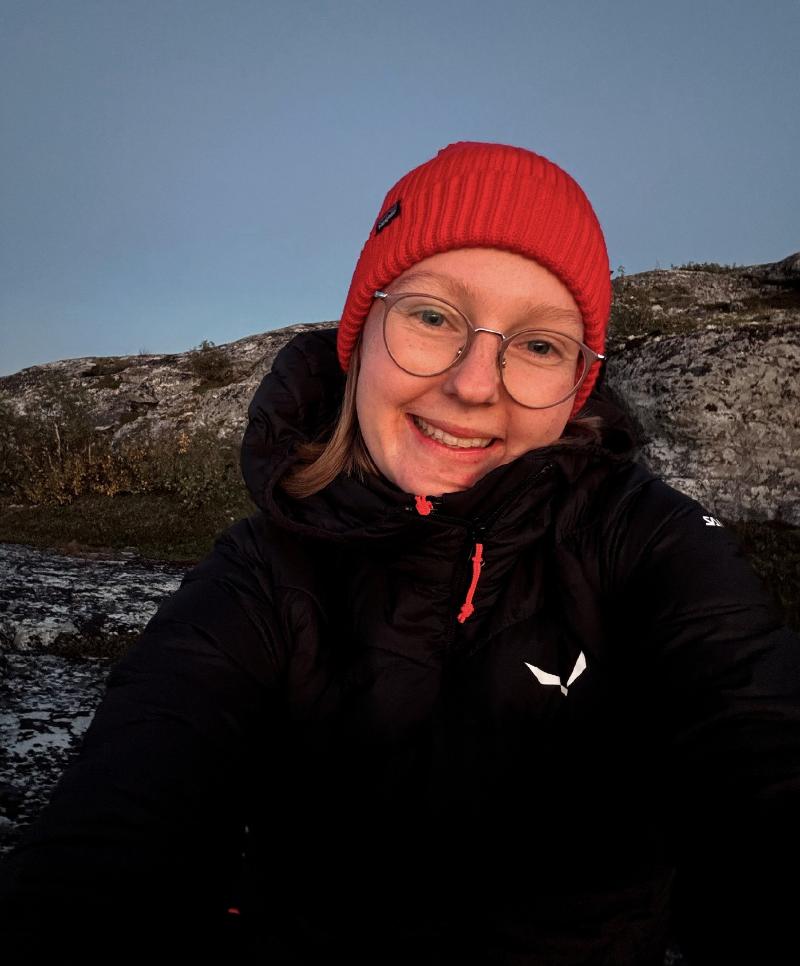“Can contribute with new perspectives and innovative solutions”
Exchange students at UiT have through the Arctic-2030 BANHER project explored the ripple effects of geopolitics and global warming on a local level in the Arctic. They have, among other things, looked closely at the extent to which Arctic port cities are dependent on cruise tourism.

Geopolitical tensions and climate changes will affect both current and future generations in Arctic communities. The local ripple effects of these issues have been explored by a group of exchange students at UiT, associated with the Northern Studies Bachelor's programme research group. They have participated in the Arctic-2030 BANHER project, which is funded by the Ministry of Foreign Affairs.
In 2024, the students engaged in workshops, interdisciplinary fieldwork, and honed their research related to local communities in Alaska, West Finnmark, and North Iceland. Additionally, they participated in the CNARC symposium and Arctic Circle Assembly, which were held in Iceland in 2024. They have mapped community development related to the blue economy, indigenous and non-indigenous populations, and tourism.
The project leaders are UiT's university lecturer Peter Haugseth, from the Northern Studies research group, and Per Kåre Jakobsen, university lecturer at the Business School, UiT in Alta.
The experiences we have gained have been crucial for establishing a link between theory and practice in an ever-evolving Arctic context.
A primary goal of the project is to build knowledge and exchange ideas from the ground up to find sustainable solutions to societal challenges, both on a social and economic level.
An important part of the project is that the students provide recommendations, based on their own investigations, on how local communities can find new ways to handle the challenges they face.

Theory and Practice
Ninon Eloïse Trentin, from France, is studying sports science and sports management at the Bachelor level at UiT in Alta. There, she also delves into subjects related to entrepreneurship, innovation, and outdoor activities.
Trentin, along with student David Ehrmann from Germany, investigated how climate change affects the stability of local communities in the Arctic, indirectly, through an increase in cruise tourism. This can also be an example of how the blue economy impacts tourism on land.
Trentin particularly highlights that by participating in workshops and discussions during the Arctic Circle Assembly, she and her fellow students gained greater insight into the challenges and opportunities that tourism represents.
"Through the project work, we wanted to find ways to engage younger generations in such discussions, so that they can contribute new perspectives and innovative solutions to the challenges that Arctic communities face. The experiences we have gained have been crucial for establishing a link between theory and practice in an ever-evolving Arctic context," says Trentin.
Hanna Marie Riedl, a German Bachelor student in Alta who has worked in the field of the blue economy, believes the project was an opportunity to develop professionally.
"I engaged in interdisciplinary subjects and realised the importance of handling topics that are not necessarily what I study. It was also interesting to see how different fields can be viewed from various perspectives, for example from the perspectives of politicians, the business community, and indigenous peoples," emphasises Riedl.
Cruise Ships in Arctic Ports
Tourism is a complex phenomenon influenced by factors such as local and international markets, local and global supply chains, or economic cycles.
Facts about Arctic-2030 BANHER
- Exchange students at UiT participate in fieldwork and research on local communities in the Arctic
- Aims to uncover how such communities are affected by geopolitical tensions and global warming
- Key topics for the students' research are indigenous peoples, the blue economy, and tourism
- The project is funded by the Norwegian Ministry of Foreign Affairs
UiTs samarbeidspartnere:
- Fridtjof Nansen Institute (FNI)
- Harvard University (USA)
- Lulelå University of Technology (Sverige)
- University of Akureyri (Island)
- University of Alaska Anchorage (USA)
- Universitetet of Bergen
- Trent University (Canada)
The students focused on Arctic ports in three countries to examine the ripple effects of tourism: Alta, Akureyri and Ísafjörður in Iceland, and Seward in Alaska, all of which are located at the innermost part of fjords that are difficult to access. Another common feature of these ports is that they have a high number of cruise ship calls. This has led to mass tourism making a significant impact on the local communities, during specific seasons.
The students' research shows that the reasons tourists choose to visit these places by cruise ship can be quite different. A key reason may be that more people want to visit the Arctic in the summer, as climate change leads to more extreme temperatures in southern Europe during this season. Both Akureyri and Seward also experience peak tourism in the summer. It should be noted that Seward, which only has a couple of hundred residents, is largely closed off in the winter due to snowstorms.
The problem is that most in the local business community would prefer land-based tourism, but they feel they have to prioritise cruise tourists.
In Alta, most tourists come in the winter, largely because the Northern Lights are a major attraction.
In the ports, measures are taken to reduce pollution and protect local nature and wildlife, which are also key attractions for tourists. The BANHER students highlighted that in Akureyri, 65 percent of waste from tourists is recycled, and the number of tourists is limited to 3000 per day, arriving via cruise ships. Akureyri also sees 30 percent more tourists in the winter, who come to view the Northern Lights.
In Alta, 81 percent of residents are happy with tourism, while 14 percent expressed concerns about future development.
"The Arctic as a region is attracting more and more tourists seeking Arctic landscapes and authentic experiences, which offers an opportunity for economic growth but also poses a sustainability challenge. This influx of tourists can also exacerbate existing vulnerabilities in local communities by putting pressure on natural resources and local culture," warns Trentin.
Strains and Dependency
Riedl points out that in Ísafjörður, 85 percent of the income for the local businesses comes from the cruise industry.

Both Trentin and Riedl note that seasonal fluctuations can create economic risks for local communities. Trentin believes that during the winter season, it becomes clear that communities in Finnmark lack the infrastructure to handle the influx of visitors and that this puts pressure on natural resources. Tourism also requires that greater community resources be used for preparedness, which can be at the expense of local communities.
Alternatives to Cruise Ships
However, Riedl also adds that there is a positive aspect to cruise tourism, as it leads to stable and predictable pre-booking of excursions, which is not possible with land-based tourism alone. This provides an important foundation for building infrastructure and financial security that can benefit other types of tourism.
Nevertheless, both Riedl and Trentin agree that it is important to reduce the vulnerability that dependency on cruise tourism poses. They believe it is crucial to make economic activities more diverse by developing other sectors, such as sustainable agriculture, fishing, or new uses of craft traditions.
"It is also crucial that local communities and stakeholders in the tourism sector collaborate to develop sustainable tourism that preserves the environment and cultural identity, while capitalising on the opportunities that the new geopolitical realities present," says Trentin.
Kortnytt fra Faculty of Humanities, Social Sciences and Education, Department of Social Sciences
-
Fiskeri- og havbruksvitenskap - bachelor
Varighet: 3 År -
Fiskeri- og havbruksvitenskap - master
Varighet: 2 År -
Akvamedisin - master
Varighet: 5 År -
Bioteknologi - bachelor
Varighet: 3 År -
Arkeologi - master
Varighet: 2 År -
Peace and Conflict Transformation - master
Varighet: 2 År -
Computer Science - master
Varighet: 2 År -
Geosciences - master
Varighet: 2 År -
Biology - master
Varighet: 2 År -
Technology and Safety in the High North - master
Varighet: 2 År -
Physics - master
Varighet: 2 År -
Molecular Sciences - master
Varighet: 2 År -
Law of the Sea - master
Varighet: 3 Semestre -
Biologi - bachelor
Varighet: 3 År -
Nordisk - årsstudium
Varighet: 1 År -
Historie - årsstudium
Varighet: 1 År -
Engelsk - årsstudium
Varighet: 1 År -
Luftfartsfag - bachelor
Varighet: 3 År -
Arkeologi - bachelor
Varighet: 3 År -
Informatikk, datamaskinsystemer - bachelor
Varighet: 3 År -
Informatikk, sivilingeniør - master
Varighet: 5 År -
Allmenn litteraturvitenskap - årsstudium
Varighet: 1 År -
Likestilling og kjønn - årsstudium
Varighet: 1 År -
Historie - bachelor
Varighet: 3 År -
Geovitenskap- bachelor
Varighet: 3 År -
Kjemi - bachelor
Varighet: 3 År -
Samfunnssikkerhet - bachelor
Varighet: 3 År -
Samfunnssikkerhet - master
Varighet: 2 År -
Kunst - bachelor
Varighet: 3 År -
Kunsthistorie - master
Varighet: 2 År -
Farmasi - master
Varighet: 2 År -
Religionsvitenskap - årsstudium
Varighet: 1 År -
Romfysikk, sivilingeniør - master
Varighet: 5 År -
Klima og miljøovervåkning, sivilingeniør - master
Varighet: 5 År -
Sosialantropologi - bachelor
Varighet: 3 År -
Bærekraftig teknologi, ingeniør - bachelor
Varighet: 3 År -
Historie - master
Varighet: 2 År -
Filosofi - bachelor
Varighet: 3 År -
Filosofi - master
Varighet: 2 År -
Anvendt fysikk og matematikk, sivilingeniør - master
Varighet: 5 År -
Barnevernsarbeid - master
Varighet: 2 År -
Forfatterstudium 2 - årsstudium
Varighet: 1 År -
Fine Art - master
Varighet: 2 År -
Barnevern - bachelor
Varighet: 3 År -
Arctic Nature Guide - one year programme
Varighet: 1 År -
Sosialt arbeid - bachelor
Varighet: 3 År -
Arktisk friluftsliv og naturguiding - bachelor
Varighet: 3 År -
Arktisk friluftsliv - årsstudium
Varighet: 1 År -
Grunnskolelærerutdanning for 1.-7. trinn - master
Varighet: 5 År -
Kunsthistorie - årsstudium
Varighet: 1 År



